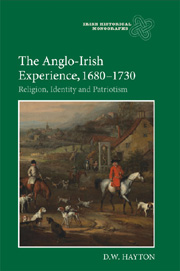Book contents
- Frontmatter
- Contents
- List of Illustrations
- Acknowledgments
- Abbreviations
- Preface
- Note on dates and quotations
- 1 From barbarian to burlesque: the changing stereotype of the Irish
- 2 Anglo-Irish attitudes: shifting perceptions of national identity
- 3 Aristocratic decline: the fall of the house of Ormond
- 4 A presence in the country: the Brodricks and their ‘interest’
- 5 ‘Commonwealthman’, unionist and king's servant: Henry Maxwell and the Whig imperative
- 6 ‘Paltry underlings of state’? The character and aspirations of the ‘Castle’ party, 1715–32
- 7 Creating industrious Protestants: charity schools and the enterprise of religious and social reformation
- 8 A question of upbringing: Thomas Prior, Sir John Rawdon, 3rd Bt, and the mentality and ideology of ‘improvement’
- Bibliography of secondary works
- Index
3 - Aristocratic decline: the fall of the house of Ormond
Published online by Cambridge University Press: 05 February 2013
- Frontmatter
- Contents
- List of Illustrations
- Acknowledgments
- Abbreviations
- Preface
- Note on dates and quotations
- 1 From barbarian to burlesque: the changing stereotype of the Irish
- 2 Anglo-Irish attitudes: shifting perceptions of national identity
- 3 Aristocratic decline: the fall of the house of Ormond
- 4 A presence in the country: the Brodricks and their ‘interest’
- 5 ‘Commonwealthman’, unionist and king's servant: Henry Maxwell and the Whig imperative
- 6 ‘Paltry underlings of state’? The character and aspirations of the ‘Castle’ party, 1715–32
- 7 Creating industrious Protestants: charity schools and the enterprise of religious and social reformation
- 8 A question of upbringing: Thomas Prior, Sir John Rawdon, 3rd Bt, and the mentality and ideology of ‘improvement’
- Bibliography of secondary works
- Index
Summary
For the Irish landed aristocracy the Williamite Revolution marked an ebb tide. Rebellions and religious wars had destroyed or weakened many older noble dynasties, while families which would in later years come to dominate the political life of Hanoverian Ireland – the Ponsonbys, Hills, Beresfords and their ilk – were still clambering out of the ranks of the gentry. Of the magnates whose rivalries had determined the course of Irish politics during the conflicts of 1640–90, some, like the Bourkes and Talbots, had been expropriated because of their Catholic political loyalty; others, such as the Annesleys and the various branches of the Boyles, had drifted into absenteeism; while a few great families, pre-eminently the Fitzgerald earls of Kildare, had lapsed into a vegetative state as the genetic inheritance of political talent that had run through their lineage dried up (temporarily in the case of the Kildares). With one important exception, Irish politics in the half-century after 1690 was dominated by ‘new men’. The exception was James Butler, second duke of Ormond, to all intents and purposes the leader of the Tory party in Ireland in Queen Anne's reign, and twice lord lieutenant, 1703–7 and 1710–13.
Ormond was set apart from his contemporaries not only by his illustrious family history, the breadth of his acreage and the size of his disposable income – profoundly impressive if judged by the criterion of his extravagant expenditure rather than by the actual balances in his accounts – but also by his possession of that traditional appurtenance of noble power, a large personal retinue.
- Type
- Chapter
- Information
- The Anglo-Irish Experience, 1680-1730Religion, Identity and Patriotism, pp. 49 - 76Publisher: Boydell & BrewerPrint publication year: 2012



